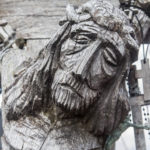We run our website the way we wished the whole internet worked: we provide high quality original content with no ads. We are funded solely by your direct support. Please consider supporting this project.

The Greatest in the Kingdom (1 of 2)
This post is a summary of what was discussed at the ReKnew CrossVision Conference in regard to what and how we teach our kids about the cruciform hermeneutic.
Article by Natalie Frisk
Recently, while involved in an all ages musical worship experience, I watched a couple of three and four-year-olds close their eyes and experience the moment, quickly followed by them running up and down an aisle, and then launching themselves into their parents’ arms. They were soon set down to repeat the aforementioned experience. It was actually an amazing cycle of their own worship. They were wrapped up into the moment (for their own petit attention span), from where they exploded with some energy, only to want to fall into the arms of a loving parent.
Cuddled. Set. Repeat.
So often, as ‘grown-ups’ we think we need to tame our kids, or to help them fall in line; or we think we have so much to teach them—if they’d only listen! But the truth is: we can learn a lot from kids. In fact, I learned that from Jesus. Not only did Jesus welcome kids to him to bless them (Matthew 19:13-15), Jesus showed others that it was actually the small children who were greatest in the kingdom. Take that in for a moment:
The kids who make noise when they should be quiet.
The kids who manage to make a mess in an empty room.
The kids who cannot contain their energy and excitement at the most inappropriate of times.
Greatest. In. The. Kingdom.
And so, when we teach our kids about God, this is our starting point: kids are the greatest in the kingdom. The kingdom of God belongs to them. That’s high value. That’s kingdom value. With that, we must seriously consider what it is that we teach them, how, and why.
Child-like faith is simple, not stupid.
Kids have an incredible capacity to absorb knowledge and apply it at various developmental stages. They can handle much more than we often present to them—especially throughout the past 30 or so years in the church.
Throughout this span of time there has been a heavy emphasis on morality-based teaching to children; Bible-story-as-morality-lesson is how things have taken shape. And though the church did its best to raise little boys and girls to be moral, it missed out on so much of the awesomeness of God’s story and our role within it. Instead, our teaching to kids has too often preached the outcomes of a life with Christ without explaining what it was to actually have that life: to know the love of the Creator, to draw close to Jesus and get to know him, and to experience the work of the Spirit in our lives.
Instead of being called into an exciting life with Christ, kids were called into a boring morality lesson—which certainly doesn’t engage kids to be life-long followers of Jesus. On the contrary, it presents them with a lackluster faith. I remember once hearing someone say: Why follow Jesus when you could just have fun?
Following Jesus can be fun, engaging, exciting—a full-on adventure! As such, our manner of conveying the story of Scripture needs to capture this. To do this, kids need to see that their own story is part of the much larger story in which Jesus is the main character—the full revelation of who God is. Jesus is the best picture of God that we have in all of Scripture. The rest of the Bible presents glimpses, but only Jesus shows us what God really looks like. Jesus, then, needs to be a central character in each kid’s own stories.
The experience that we present kids with from a very early age will help to shape this understanding. Early childhood learning experience is multilayered: kids are being introduced to God, God’s story, and their foundational understanding of God is being shaped. In fact, studies show that our foundational understanding of who God is has taken significant shape by the age of five. If our portrait of God is based on really poor theological reflections of God through poorly presented text, that is going to leave the wrong impression on our kids.
Kids are also developing their repertoire of stories, characters, and themes to draw on later while tackling larger theological questions in their youth and adulthood. They are doing this while discovering a sense of belonging in the broader church body.
That’s a lot for kids. So where do we start?
Jesus. Jesus. Jesus.
I once heard a story of a Christian man who was the principal of a school in an area of the Middle East heavily occupied with Muslims. The Christian school began at preschool: however, the surrounding Muslim schools did not begin until kids were in the first grade. For a variety of reasons, Muslim families sent their children to the Christian school for preschool. The principal was asked, “What do you teach those children in preschool?” He replied, “Jesus. Jesus. Jesus.” He knew that he’d only have those kids for a year or two and that was his opportunity to shape their understanding of the God who is Jesus.
And so, that’s where I begin: with Jesus. The same Jesus who welcomed little children to bless them. The same Jesus who took a little child and called him the greatest in the kingdom. The Jesus who shows us: God is love.
Category: General, Guest Contributor
Tags: Crucifixion of the Warrior God, Cruciform Theology, Kids
Guest Contributor:

Natalie Frisk serves as the curriculum pastor at The Meeting House – a multisite church in Canada, overseeing the development of kids and youth teaching from birth to end of high school. She’s been in pastoral ministry for over a decade in an ever-changing multisite landscape. Natalie is presently working towards a Doctor in Practical Theology (McMaster Divinity College) with a focus on the spirituality of children. She is the author of a new book, Raising Disciples: How to Make Faith Matter to Our Kids (Herald Press, 2019) that is presently available for pre-order now.
Related Reading

The Cruciform Way of the Lamb
In this video, Greg offers insight into how to read the Bible with the cross at the center of the revelation of God, thereby reframing how we interpret the violent and nationalistic passages of the Old Testament. Travis Reed from The Work of the People did a series of interviews with Greg a while ago and…

Overemphasizing Christ?
In response to my work, some have argued that I tend to overemphasize Christ. In light of the claim that in Jesus we have the one and only definitive Word of God and that no previous revelation should ever be placed alongside him or allowed to qualify what he reveals about God, some allege that…

Cross Vision Coming Soon!
In Greg’s new book, Cross Vision, he explains how the crucifixion of Jesus makes sense of the violent portraits of God in the Old Testament. His groundbreaking “cruciform hermeneutic” will change the way that you read the Bible! While Crucifixion of the Warrior God laid out Greg’s case in detail for an academic audience, Cross Vision…

Reviewing the Reviews: Tom Belt (Part 2)
In my previous post I reviewed Tom’s critical review of volume 1 of CWG, and in this post I’d like to do the same for his critical review of volume 2. As he did in his review of volume I, Tom begins with some praises and points of agreement. He thinks my quest to discern “what…

Do the Gospels Fabricate Prophetic Fulfillment?
Skeptically-inclined scholars, and especially critics of Christianity, frequently argue that the Gospel authors created mythological portraits of Jesus largely on the basis of OT material they claim Jesus “fulfilled.” In other words, they surveyed the OT and fabricated stories about how Jesus fulfilled those prophecies. In response, it’s hard to deny that there are certain…

The Key to Understanding the Bible
In yesterday’s post we discussed how Jesus is the starting point for interpreting Scripture. If this is the case and Jesus is the subject matter of all Scripture, then the ultimate challenge is to disclose how each aspect of Scripture bears witness to his subject. To state it otherwise, if the intended function of all Scripture is to mediate…
